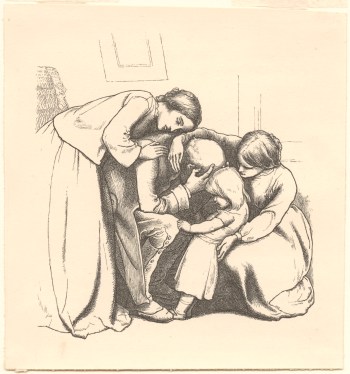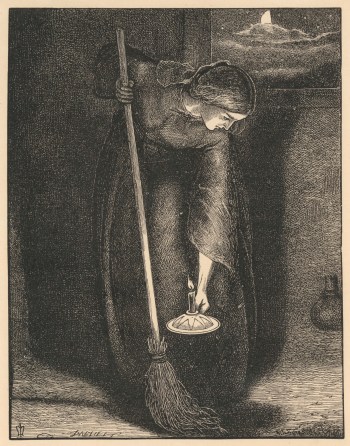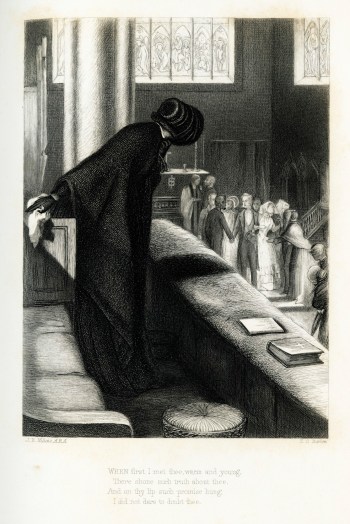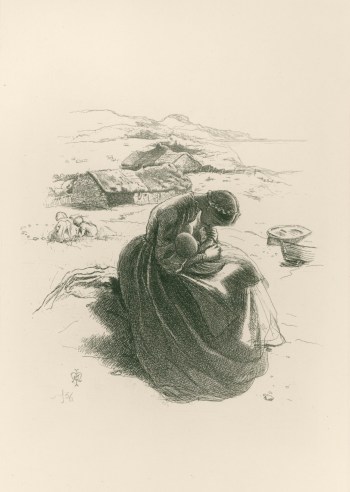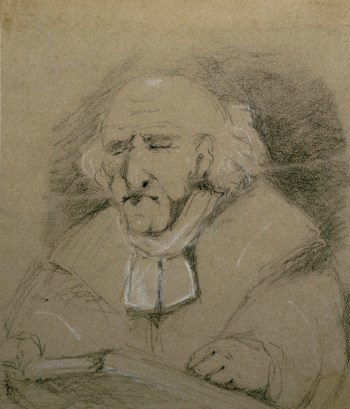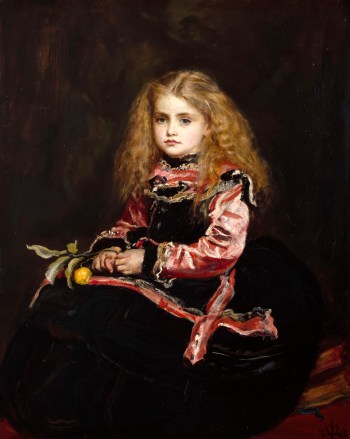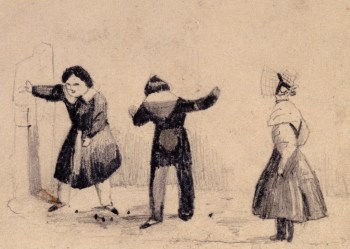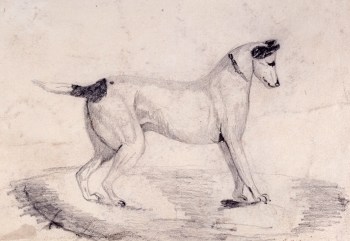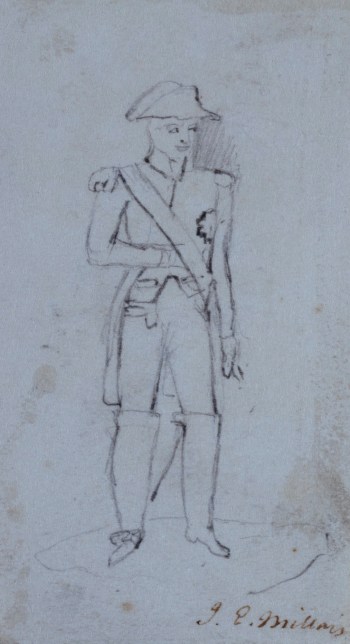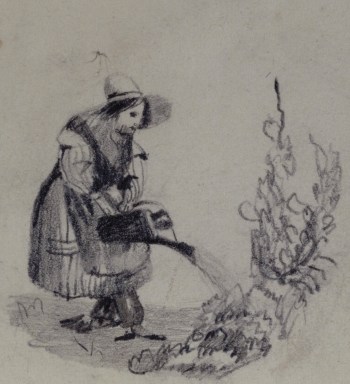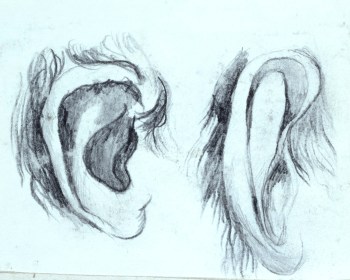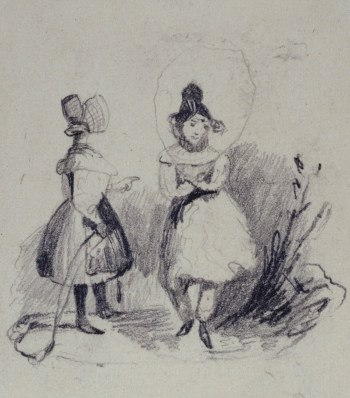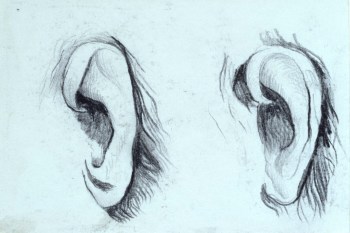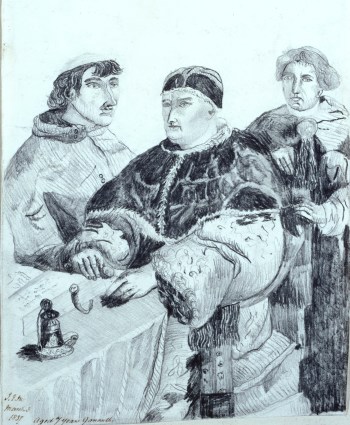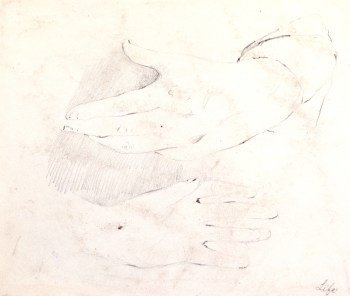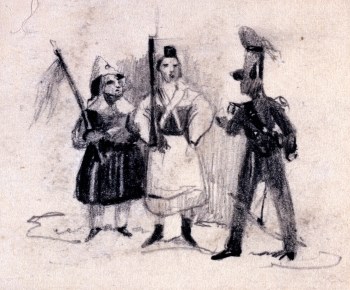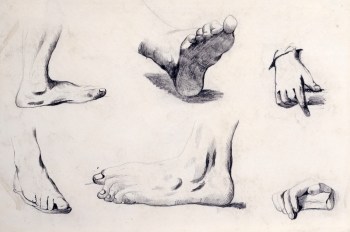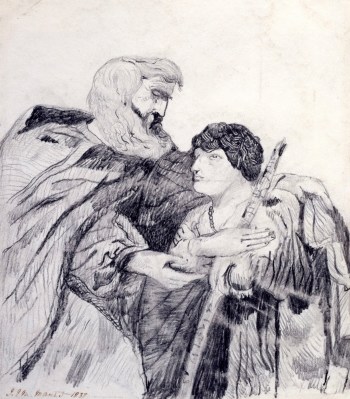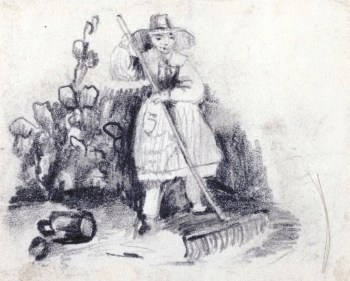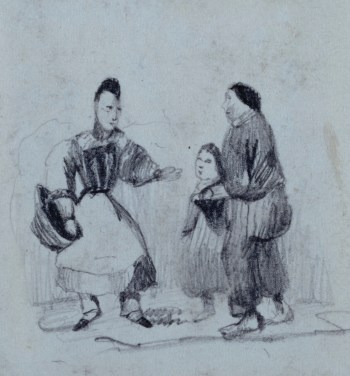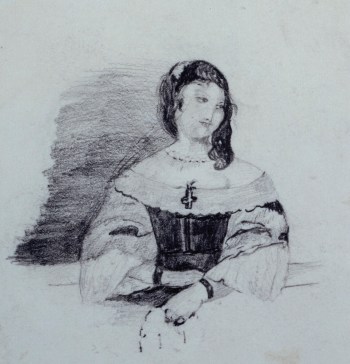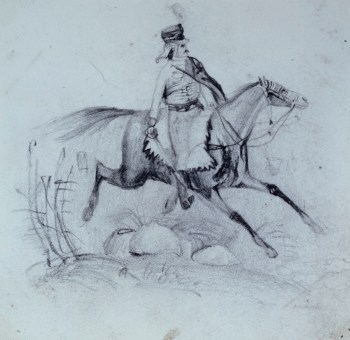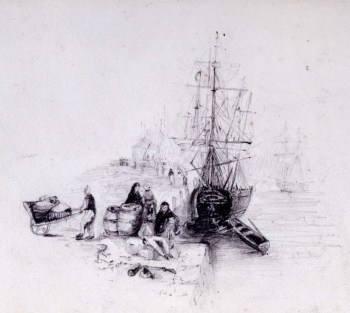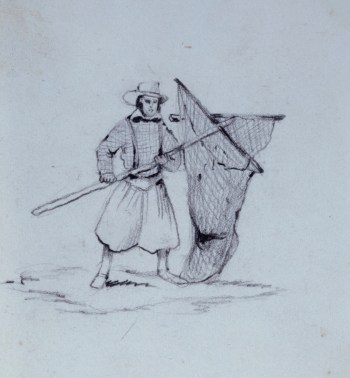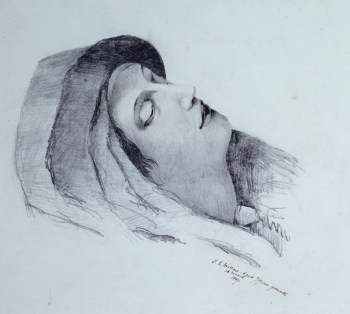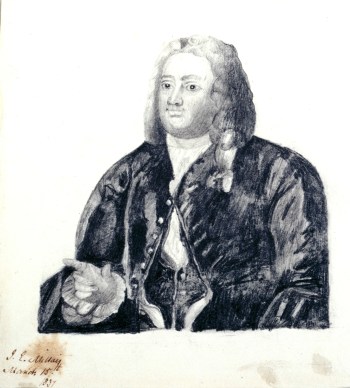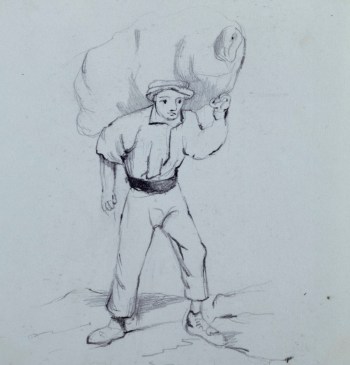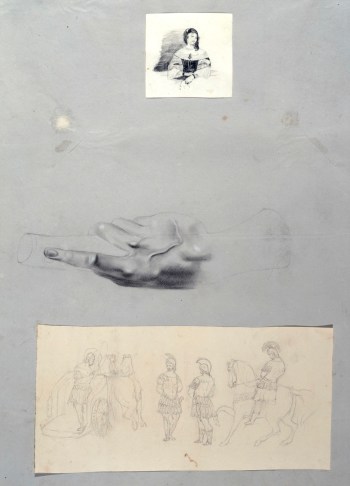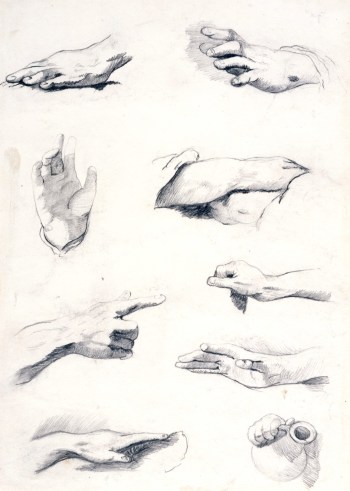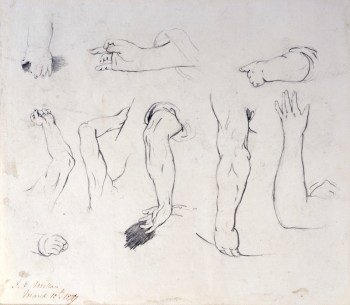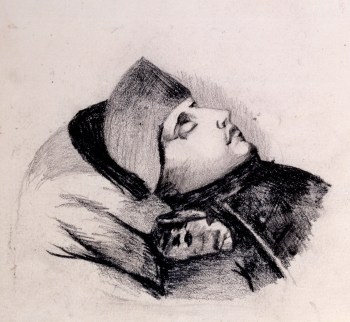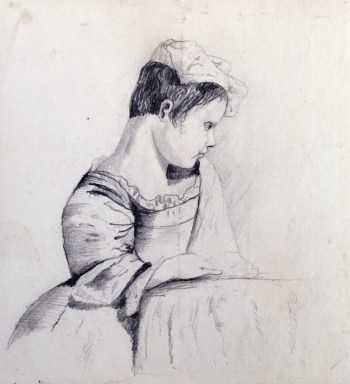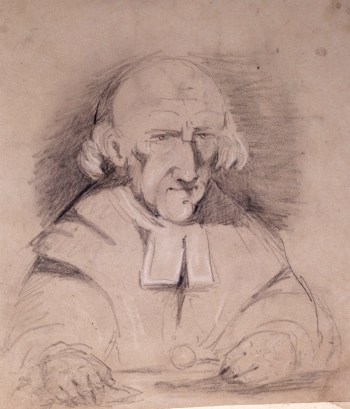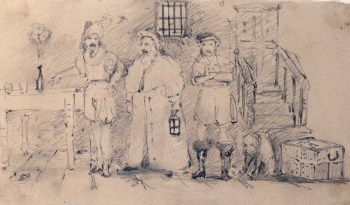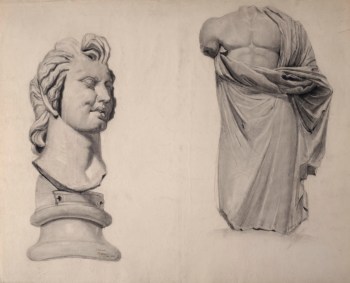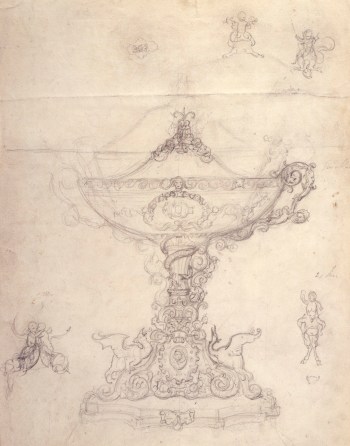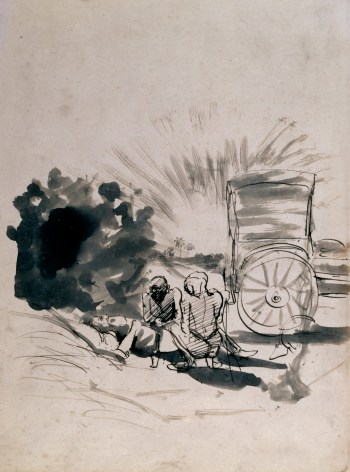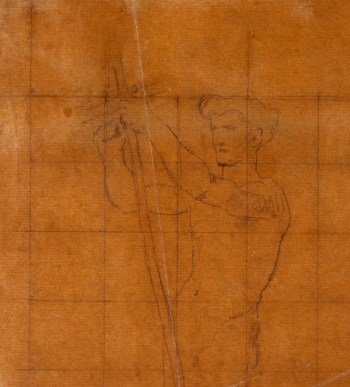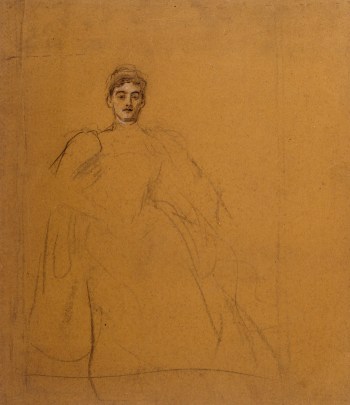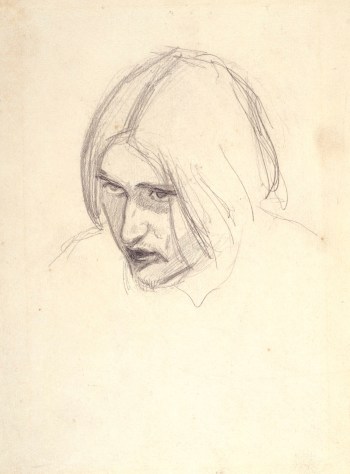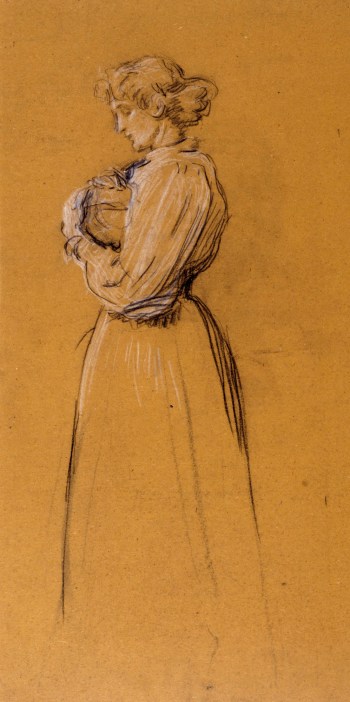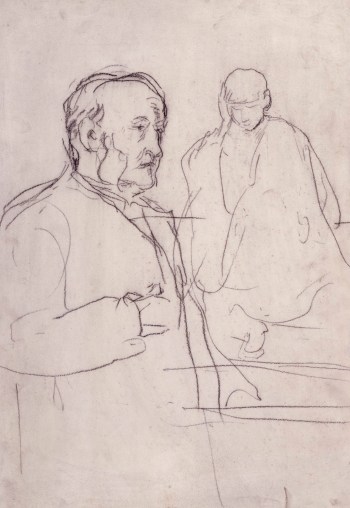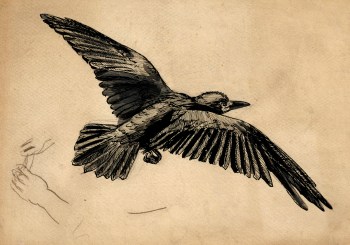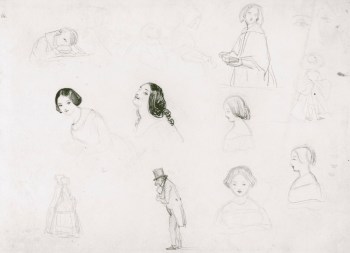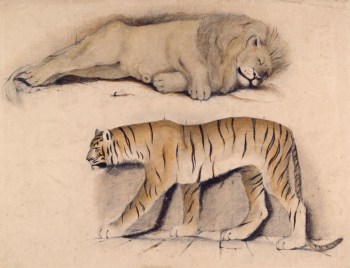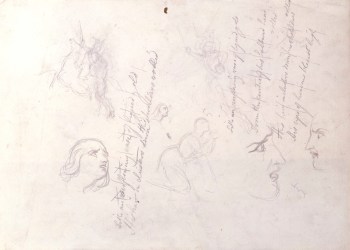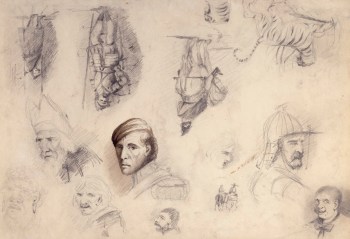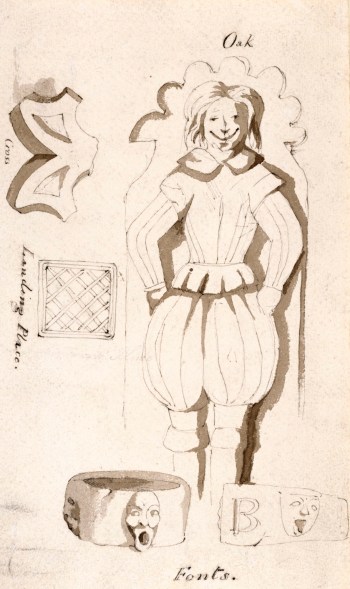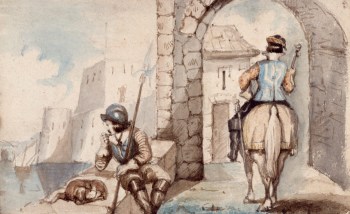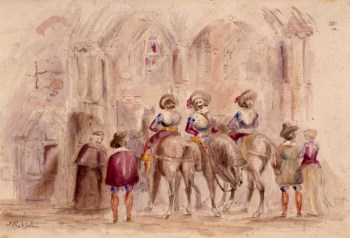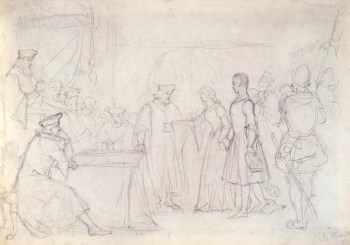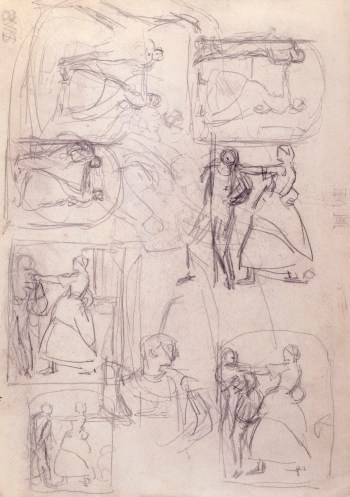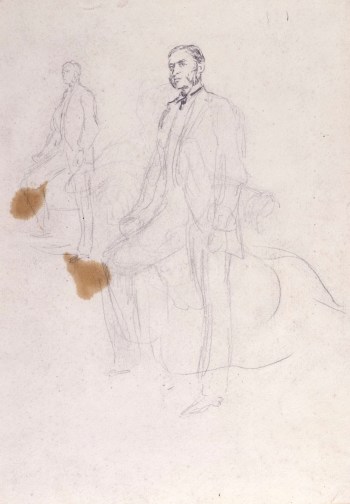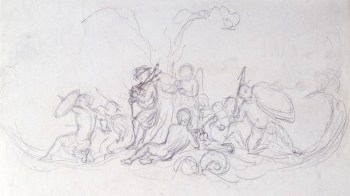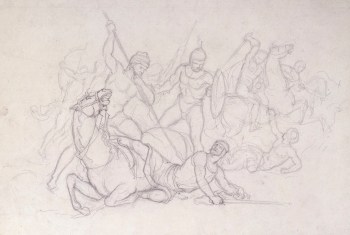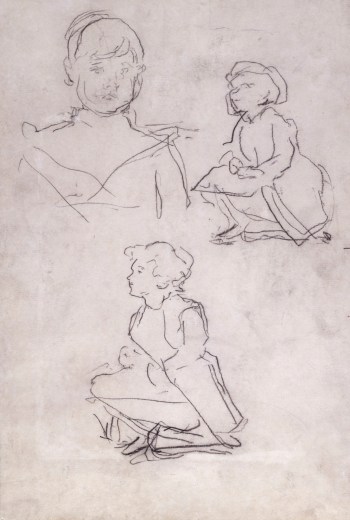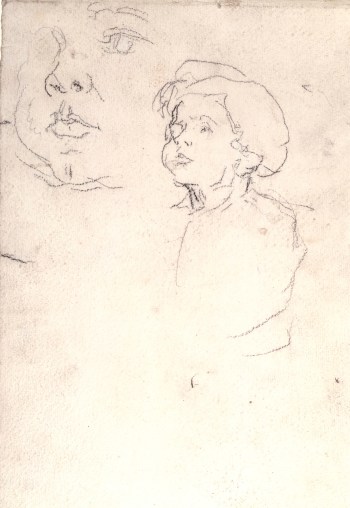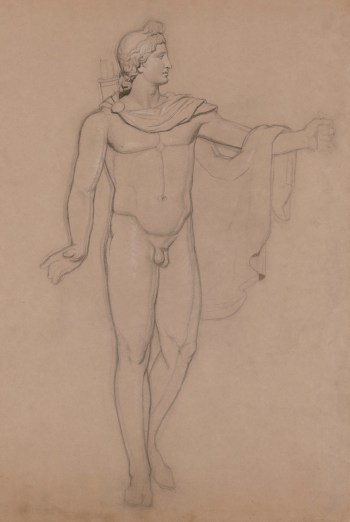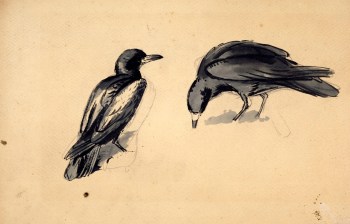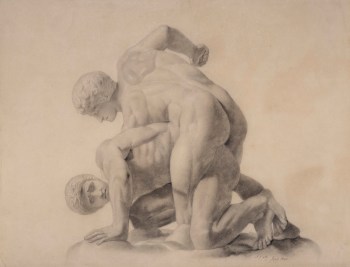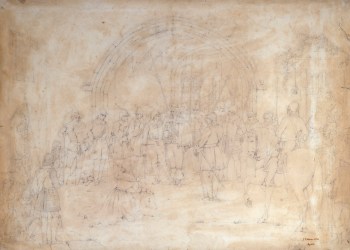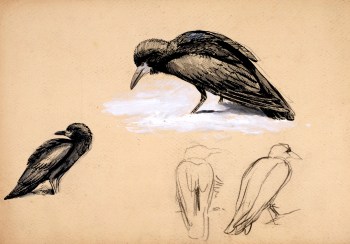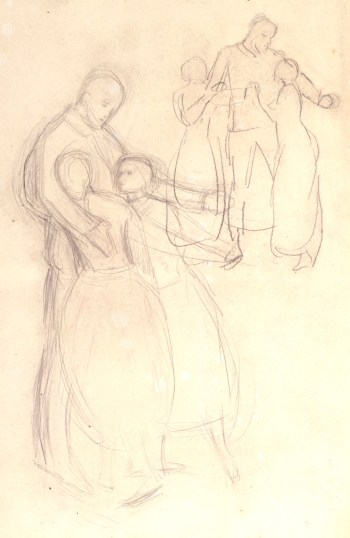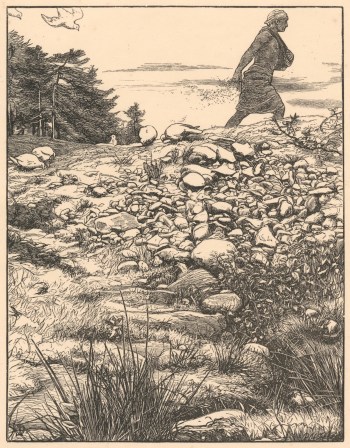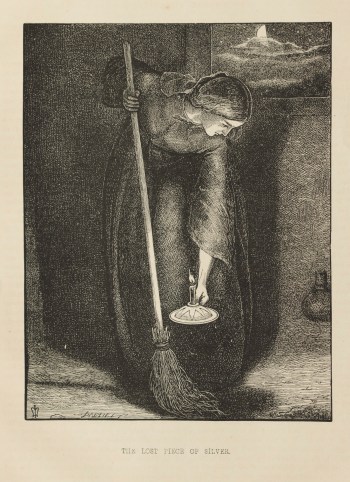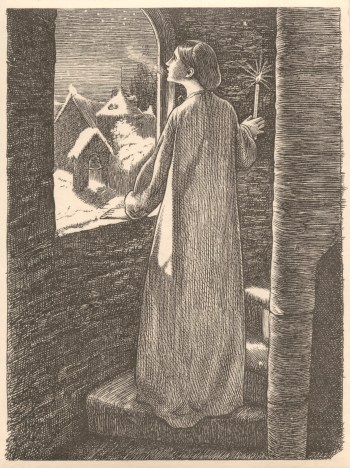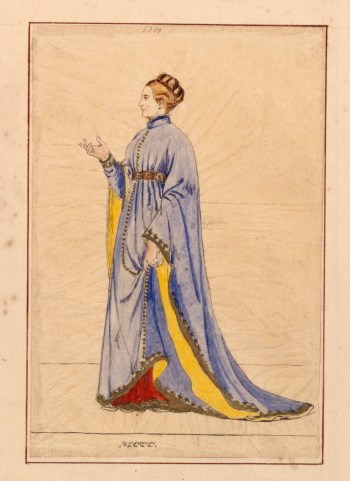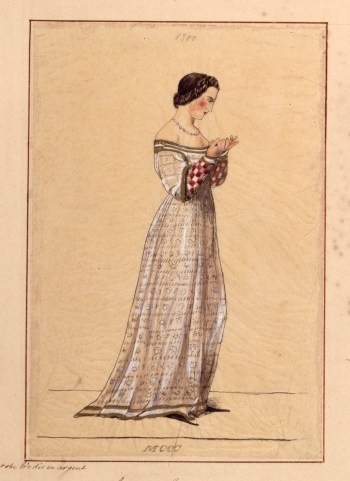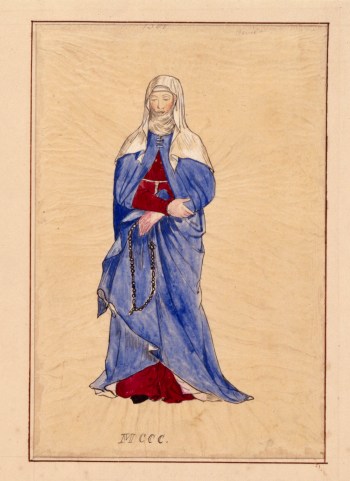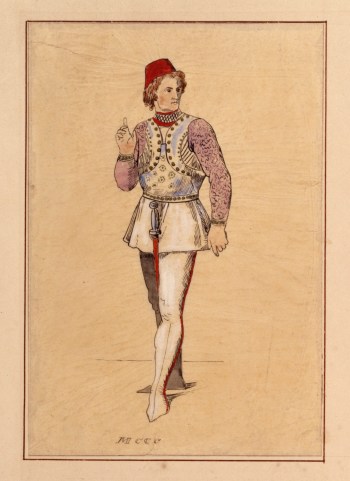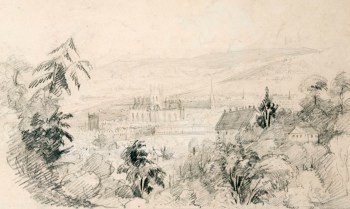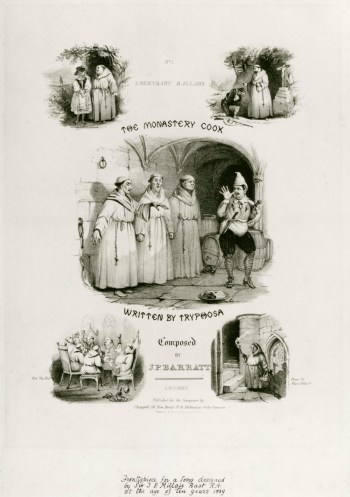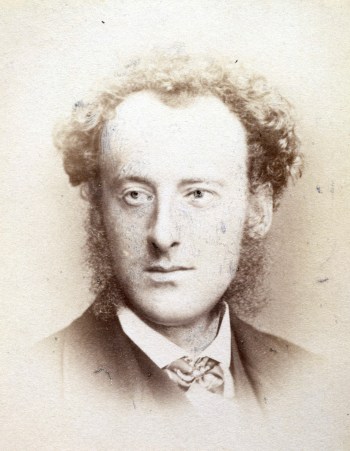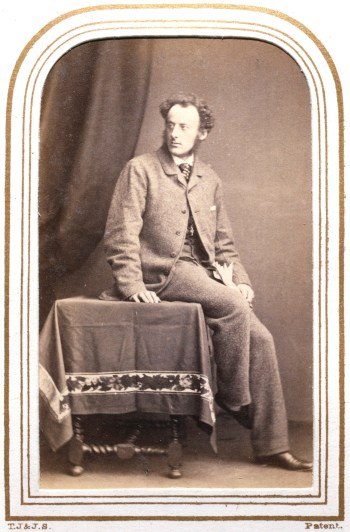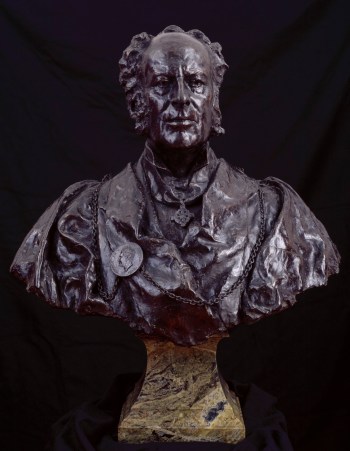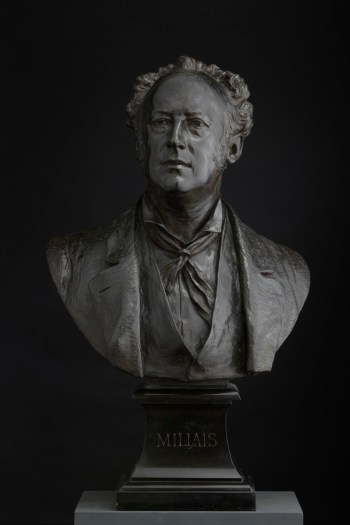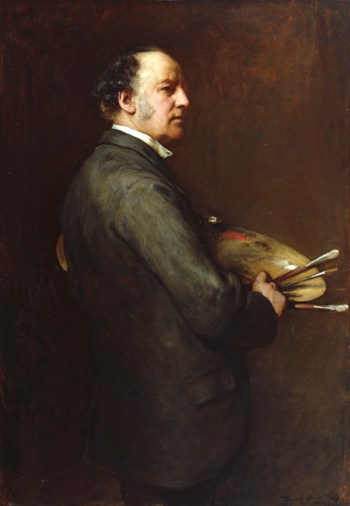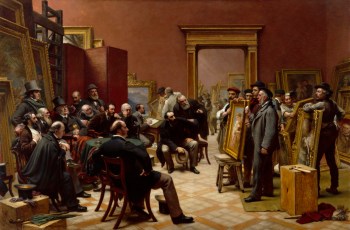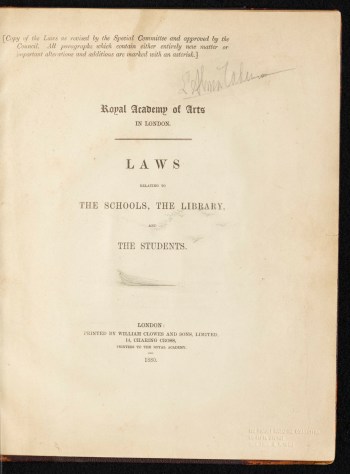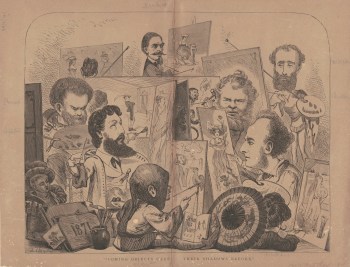Sir John Everett Millais Bt. PRA (1829 - 1896)
RA Collection: People and Organisations
A founding member of the Pre-Raphaelite Brotherhood, Sir John Everett Millais was internationally renowned during his lifetime, and his career culminated in his election as President of the Royal Academy in 1896.
As a child, Millais displayed a precocious artistic talent. In 1838 a meeting with Martin Archer Shee, the then President of the Royal Academy, led to Millais enrolling at Henry Sass’s private drawing school in London. In 1840, aged only eleven, he became the youngest artist ever admitted to the Royal Academy Schools. Known to his fellow students as ‘the Child’, Millais won his first RA silver medal in 1843.
While studying at the Royal Academy Schools, Millais and a group of like-minded colleagues including Dante Gabriel Rossetti and William Holman Hunt established the Pre-Raphaelite Brotherhood, the first avant-garde group in the history of British art. The PRB reacted against the prevailing view at the RA, and elsewhere, that Raphael and the later Renaissance tradition represented the artistic ideal. Instead, they drew inspiration from earlier artists including Jan van Eyck and Albrecht Dürer whom they believed to have drawn more directly from nature.
Millais’ early statement of PRB principles, Christ in the House of his Parents, was exhibited at the Royal Academy in 1850. Intended as a realistic corrective to traditional ‘Raphaelite’ depictions of the Holy Family, it met with almost universal disdain - Charles Dickens was amongst its strongest critics, warning his readers that the painting depicted ‘the lowest depths of what is mean, odious, repulsive, and revolting’. Subsequent paintings such as Ophelia and A Hugenot (both exhibited at the RA in 1852) were received more positively, however, and paved the way for Millais’ election as an associate of the Royal Academy in 1853.
By this time the great writer on art John Ruskin had begun championing Millais’ work, and it was while staying with Ruskin in Scotland in 1853 that Millais and Ruskin’s wife Effie Gray fell in love. Ruskin and Gray’s marriage was annulled on the grounds that it had never been consummated, leaving her free to marry Millais in 1855.
After their marriage, Millais and Effie lived in Perth for six years, and his art moved away from the tight observation of his earlier work to more generally atmospheric scenes like the one portrayed in Autumn Leaves. In 1861 the family returned to London and Millais was elected a Royal Academician in 1863. By this time Millais had acquired a taste for the Old Masters which ran contrary to his early PRB ideals—his RA diploma work was even titled A Souvenir of Velasquez.
In later years, portraiture became increasingly central to Millais’ practice, while reproductive prints provided a lucrative way of disseminating his work. In 1896, Millais succeeded Frederic Leighton as President of the Royal Academy, although he was seriously ill with cancer of the larynx, and died only six months after his election.
Profile
Born: 8 June 1829 in Southampton, Hampshire, England, United Kingdom
Died: 13 August 1896
Nationality: British
RA Schools student from 12 December 1840
Elected ARA: 7 November 1853
Elected RA: 18 December 1863
President from: 1896 - 1896
Gender: Male
Preferred media: Painting and Illustration
Works by Sir John Everett Millais in the RA Collection
82 results
-
![Sir John Everett Millais Bt. PRA, Love]()
Sir John Everett Millais Bt. PRA
Love
Wood-engraving
-
![Sir John Everett Millais Bt. PRA, Dora]()
Sir John Everett Millais Bt. PRA
Dora
Wood-engraving
-
![Sir John Everett Millais Bt. PRA, On the Water]()
Sir John Everett Millais Bt. PRA
On the Water, 23rd July 1859
Wood-engraving
-
![Sir John Everett Millais Bt. PRA, The Lost Piece of Silver]()
Sir John Everett Millais Bt. PRA
The Lost Piece of Silver, 1863
Wood-engraving
-
![Sir John Everett Millais Bt. PRA, When first I met thee, warm and young...]()
Sir John Everett Millais Bt. PRA
When first I met thee, warm and young...
Steel engraving
-
![Sir John Everett Millais Bt. PRA, Etchings For The Art-Union Of London By The Etching Club.]()
Sir John Everett Millais Bt. PRA
The Young Mother, 1857
Etching
-
![Sir John Everett Millais Bt. PRA, Fragment of a drawing of a man in historic dress]()
Sir John Everett Millais Bt. PRA
Fragment of a drawing of a man in historic dress, ca. 1837
Pencil on brown wove paper
-
![Sir John Everett Millais Bt. PRA, A Souvenir of Velazquez]()
Sir John Everett Millais Bt. PRA
A Souvenir of Velazquez, 1868
Oil on canvas
-
![Sir John Everett Millais Bt. PRA, Three figures at a water pump]()
Sir John Everett Millais Bt. PRA
Three figures at a water pump, ca. 1837
Pencil on beige wove paper
-
![Sir John Everett Millais Bt. PRA, A dog in profile]()
Sir John Everett Millais Bt. PRA
A dog in profile, ca. 1837
Pencil on off-white wove paper
-
![Sir John Everett Millais Bt. PRA, Small standing figure in naval uniform, probably Lord Nelson]()
Sir John Everett Millais Bt. PRA
Small standing figure in naval uniform, probably Lord Nelson, ca. 1837
Pencil on off-white paper
-
![Sir John Everett Millais Bt. PRA, A woman watering plants in a garden]()
Sir John Everett Millais Bt. PRA
A woman watering plants in a garden, ca. 1837
Pencil on beige wove paper
-
![Sir John Everett Millais Bt. PRA, Two studies of ears]()
Sir John Everett Millais Bt. PRA
Two studies of ears, ca. 1837
Pencil on cream wove paper
-
![Sir John Everett Millais Bt. PRA, Drawing of a tavern scene with card players, probably after a Dutch painting]()
Sir John Everett Millais Bt. PRA
Drawing of a tavern scene with card players, probably after a Dutch painting
Pencil on cream wove paper
-
![Sir John Everett Millais Bt. PRA, Drawing of two female figures skipping]()
Sir John Everett Millais Bt. PRA
Drawing of two female figures skipping, ca. 1837
Pencil on beige wove paper
-
![Sir John Everett Millais Bt. PRA, Two studies of ears]()
Sir John Everett Millais Bt. PRA
Two studies of ears, ca. 1837
Pencil on cream wove paper
-
![Sir John Everett Millais Bt. PRA, Drawing after Murillo's 'The Young Beggar']()
Sir John Everett Millais Bt. PRA
Drawing after Murillo's 'The Young Beggar', March 1837
Pencil on cream wove paper
-
![Sir John Everett Millais Bt. PRA, Drawing after Raphael's portrait of Pope Leo X and two cardinals]()
Sir John Everett Millais Bt. PRA
Drawing after Raphael's portrait of Pope Leo X and two cardinals, March 1837
Pencil on cream wove paper
-
![Sir John Everett Millais Bt. PRA, Three figures, one with arms outstretched]()
Sir John Everett Millais Bt. PRA
Three figures, one with arms outstretched, ca. 1837
Pencil on cream wove paper
-
![Sir John Everett Millais Bt. PRA, A pair of hands]()
Sir John Everett Millais Bt. PRA
A pair of hands, late 1830s
Pencil on cream wove paper
-
![Sir John Everett Millais Bt. PRA, Three figures in military dress]()
Sir John Everett Millais Bt. PRA
Three figures in military dress, ca. 1837
Pencil on cream wove paper
-
![Sir John Everett Millais Bt. PRA, A seated woman]()
Sir John Everett Millais Bt. PRA
A seated woman, ca. 1837
Pencil on cream wove paper
-
![Sir John Everett Millais Bt. PRA, Studies of feet and hands]()
Sir John Everett Millais Bt. PRA
Studies of feet and hands, ca. 1837
Pencil on cream wove paper
-
![, Half length drawing of a bearded man with a child]()
Half length drawing of a bearded man with a child
Wove paper
-
![Sir John Everett Millais Bt. PRA, A figure holding a rake]()
Sir John Everett Millais Bt. PRA
A figure holding a rake, ca. 1837
Pencil on cream wove paper
-
![Sir John Everett Millais Bt. PRA, Three standing figures - two adults and a child]()
Sir John Everett Millais Bt. PRA
Three standing figures - two adults and a child, ca. 1837
Pencil on cream wove paper
-
![Sir John Everett Millais Bt. PRA, Roman soldiers]()
Sir John Everett Millais Bt. PRA
Roman soldiers, ca. 1837
Pencil on cream wove paper
-
![Sir John Everett Millais Bt. PRA, Half length portrait of a woman in historic dress]()
Sir John Everett Millais Bt. PRA
Half length portrait of a woman in historic dress, ca. 1837
Pencil on cream wove paper
-
![Sir John Everett Millais Bt. PRA, A cavalryman on horseback]()
Sir John Everett Millais Bt. PRA
A cavalryman on horseback, ca. 1837
Pencil on cream wove paper
-
![Sir John Everett Millais Bt. PRA, A ship in harbour with passengers on the dock]()
Sir John Everett Millais Bt. PRA
A ship in harbour with passengers on the dock, ca. 1837
Pencil on cream wove paper
-
![Sir John Everett Millais Bt. PRA, A man carrying a large fishing net]()
Sir John Everett Millais Bt. PRA
A man carrying a large fishing net, ca. 1837
Pencil on cream wove paper
-
![Sir John Everett Millais Bt. PRA, Drawing of the head of the Virgin Mary from Correggio's 'Ecce Homo']()
Sir John Everett Millais Bt. PRA
Drawing of the head of the Virgin Mary from Correggio's 'Ecce Homo', 16 March 1837
Pencil on wove paper
-
![Sir John Everett Millais Bt. PRA, A man resting on a rock]()
Sir John Everett Millais Bt. PRA
A man resting on a rock, ca. 1837
Pencil on cream wove paper
-
![Sir John Everett Millais Bt. PRA, Sketch after a print of Hogarth's portrait of Martin Folkes]()
Sir John Everett Millais Bt. PRA
Sketch after a print of Hogarth's portrait of Martin Folkes, March 15th 1837
Pencil on cream wove paper
-
![Sir John Everett Millais Bt. PRA, A man carrying a sack]()
Sir John Everett Millais Bt. PRA
A man carrying a sack, ca. 1837
Pencil on cream wove paper
-
![Sir John Everett Millais Bt. PRA, Album sheet with Millais drawings attached]()
Sir John Everett Millais Bt. PRA
Album sheet with Millais drawings attached, ca. 1837
Black and white chalk on grey wove paper
-
![Sir John Everett Millais Bt. PRA, Sheet of studies of a nose, mouth and chin]()
Sir John Everett Millais Bt. PRA
Sheet of studies of a nose, mouth and chin, ca. 1837
Pencil on off white wove paper
-
![Sir John Everett Millais Bt. PRA, Sheet of studies of hands]()
Sir John Everett Millais Bt. PRA
Sheet of studies of hands, ca. 1837
Pencil on off-white wove paper
-
![Sir John Everett Millais Bt. PRA, Sheet of studies of arms and hands]()
Sir John Everett Millais Bt. PRA
Sheet of studies of arms and hands, March 10th 1837
Pencil on off white wove paper
-
![Sir John Everett Millais Bt. PRA, Napoleon Bonaparte lying in state]()
Sir John Everett Millais Bt. PRA
Napoleon Bonaparte lying in state, ca. 1837
Pencil on cream wove paper
-
![Sir John Everett Millais Bt. PRA, Half length drawing of a young girl in profile]()
Sir John Everett Millais Bt. PRA
Half length drawing of a young girl in profile, ca. 1837
Pencil on off white wove paper
-
![Sir John Everett Millais Bt. PRA, Head and shoulders of an old man]()
Sir John Everett Millais Bt. PRA
Head and shoulders of an old man, ca. 1837
Black and white chalk on light brown wove paper
-
![Sir John Everett Millais Bt. PRA, Three figures in historic dress in an interior]()
Sir John Everett Millais Bt. PRA
Three figures in historic dress in an interior, ca.1837
Pencil on beige wove paper
-
![Sir John Everett Millais Bt. PRA, Drawings of antique statues in the British Museum collection]()
Sir John Everett Millais Bt. PRA
Drawings of antique statues in the British Museum collection, July 1843
Black chalk on cream wove paper - chalk rubbed out in places to create highlights
-
![Sir John Everett Millais Bt. PRA, Design for an elaborate covered cup]()
Sir John Everett Millais Bt. PRA
Design for an elaborate covered cup, 1843 or later
Pencil on cream wove paper
-
![Sir John Everett Millais Bt. PRA, Study for 'The Last Trek']()
Sir John Everett Millais Bt. PRA
Study for 'The Last Trek', 1894-1896
Pen and ink on thin, light green, wove paper
-
![Sir John Everett Millais Bt. PRA, Squared up sketch for 'A Forerunner']()
Sir John Everett Millais Bt. PRA
Squared up sketch for 'A Forerunner', 1895-6
Pencil on tracing paper
-
![Sir John Everett Millais Bt. PRA, Study for the portrait of Candida, Marchioness of Tweeddale]()
Sir John Everett Millais Bt. PRA
Study for the portrait of Candida, Marchioness of Tweeddale, 1894 -1896
Black chalk drawing with white highlights on thick green/yellow paper
-
![Sir John Everett Millais Bt. PRA, Arthur Hughes, portrait study for 'The Proscribed Royalist']()
Sir John Everett Millais Bt. PRA
Arthur Hughes, portrait study for 'The Proscribed Royalist', 1852
Pencil on cream wove paper
-
![, The Marble Faun]()
The Marble Faun
Pencil on cream wove paper
-
![Sir John Everett Millais Bt. PRA, Study for 'The Last Trek']()
Sir John Everett Millais Bt. PRA
Study for 'The Last Trek', 1895-6
Black and white chalk on thick green/yellow wove paper
-
![Sir John Everett Millais Bt. PRA, Sketch for 'A Forerunner' and other drawings]()
Sir John Everett Millais Bt. PRA
Sketch for 'A Forerunner' and other drawings, 1896
Black and white chalk on straw board
-
![Sir John Everett Millais Bt. PRA, Sketch for a three-quarter length portrait of a man]()
Sir John Everett Millais Bt. PRA
Sketch for a three-quarter length portrait of a man, Probably 1870s
Black chalk on off-white wove card
-
![Sir John Everett Millais Bt. PRA, A rook in flight - a study for 'Christmas Eve, 1887']()
Sir John Everett Millais Bt. PRA
A rook in flight - a study for 'Christmas Eve, 1887'
Pen and ink on buff-coloured card
-
![Sir John Everett Millais Bt. PRA, Old Age]()
Sir John Everett Millais Bt. PRA
Old Age, 1847-8
Pen and black ink on cream wove paper
-
![Sir John Everett Millais Bt. PRA, Childhood]()
Sir John Everett Millais Bt. PRA
Childhood, 1847-8
Pen and black ink on cream wove paper
-
![Sir John Everett Millais Bt. PRA, Sheet of sketches of heads and figures]()
Sir John Everett Millais Bt. PRA
Sheet of sketches of heads and figures, ca. 1845
Pencil on off-white wove paper
-
![Sir John Everett Millais Bt. PRA, A tiger and a sleeping lion]()
Sir John Everett Millais Bt. PRA
A tiger and a sleeping lion, late 1830s
Watercolour, with pencil drawing beneath, on cream wove paper
-
![Sir John Everett Millais Bt. PRA, Preparatory drawings for 'Elgiva']()
Sir John Everett Millais Bt. PRA
Preparatory drawings for 'Elgiva', 1846 -1847
Pencil on off-white wove paper
-
![Sir John Everett Millais Bt. PRA, Infantryman carrying a pike]()
Sir John Everett Millais Bt. PRA
Infantryman carrying a pike, ca. 1838-1839
Pencil and watercolour on thick cream wove paper
-
![Sir John Everett Millais Bt. PRA, Sketches of heads, soldiers and tigers]()
Sir John Everett Millais Bt. PRA
Sketches of heads, soldiers and tigers, 1838 or later
Pencil and watercolour on cream wove paper
-
![Sir John Everett Millais Bt. PRA, Drawings of sculpture and carvings in a church]()
Sir John Everett Millais Bt. PRA
Drawings of sculpture and carvings in a church, ca. 1844
Pen and ink on thick, cream wove paper
-
![Sir John Everett Millais Bt. PRA, A knight and an infantryman]()
Sir John Everett Millais Bt. PRA
A knight and an infantryman, ca.1840
Watercolour paint on cream wove paper
-
![Sir John Everett Millais Bt. PRA, Cavalrymen conferring with a clergyman]()
Sir John Everett Millais Bt. PRA
Cavalrymen conferring with a clergyman, ca.1840
Watercolour paint, over pencil outline, on thick cream wove paper
-
![Sir John Everett Millais Bt. PRA, A Scene from Othello]()
Sir John Everett Millais Bt. PRA
A Scene from Othello, 1846
Pencil on cream wove paper
-
![Sir John Everett Millais Bt. PRA, Sketches of a couple fighting]()
Sir John Everett Millais Bt. PRA
Sketches of a couple fighting
Pencil on cream wove paper
-
![Sir John Everett Millais Bt. PRA, Preparatory drawings for a portrait, possibly of Hugh Lupus Duke of Westminster]()
Sir John Everett Millais Bt. PRA
Preparatory drawings for a portrait, possibly of Hugh Lupus Duke of Westminster, 1870s
Thick buff coloured wove paper
-
![Sir John Everett Millais Bt. PRA, Bacchanale with bagpipes]()
Sir John Everett Millais Bt. PRA
Bacchanale with bagpipes, ca. 1853
Pencil on cream wove paper
-
![Sir John Everett Millais Bt. PRA, Photograph of a marble fireplace]()
Sir John Everett Millais Bt. PRA
Photograph of a marble fireplace, ca. 1880
Pencil
-
![Sir John Everett Millais Bt. PRA, Battle scene]()
Sir John Everett Millais Bt. PRA
Battle scene, ca. 1843
Pencil on cream wove paper
-
![Sir John Everett Millais Bt. PRA, Drawings of a child, possibly for 'Bubbles']()
Sir John Everett Millais Bt. PRA
Drawings of a child, possibly for 'Bubbles', ca.1885
Chalk on thin beige wove paper
-
![Sir John Everett Millais Bt. PRA, Drawings of a boy]()
Sir John Everett Millais Bt. PRA
Drawings of a boy, 1891 or later
Black chalk on thick cream wove paper
-
![Sir John Everett Millais Bt. PRA, The Apollo Belvedere]()
Sir John Everett Millais Bt. PRA
The Apollo Belvedere, December 1841
Black and white chalk on brown wove paper
-
![Sir John Everett Millais Bt. PRA, Study of two rooks for 'Christmas Eve 1887']()
Sir John Everett Millais Bt. PRA
Study of two rooks for 'Christmas Eve 1887', 1887-8
Pen and ink on buff-coloured wove card
-
![Sir John Everett Millais Bt. PRA, The Pancrastinae]()
Sir John Everett Millais Bt. PRA
The Pancrastinae, January 1842
Pencil and chalk on cream wove paper
-
![Sir John Everett Millais Bt. PRA, A Woman Presenting a Petition to a Cavalier]()
Sir John Everett Millais Bt. PRA
A Woman Presenting a Petition to a Cavalier, 1841
Pencil on thick cream wove paper
-
![Sir John Everett Millais Bt. PRA, Study of four rooks for 'Christmas Eve 1887']()
Sir John Everett Millais Bt. PRA
Study of four rooks for 'Christmas Eve 1887'
Pen and ink with gouache, charcoal and pencil on thick buff coloured wove card
-
![Sir John Everett Millais Bt. PRA, Preparatory drawing for 'The Ransom']()
Sir John Everett Millais Bt. PRA
Preparatory drawing for 'The Ransom', 1853 or later
Pencil on paper
-
![Sir John Everett Millais Bt. PRA, The Parable of the Sower.]()
Sir John Everett Millais Bt. PRA
The Parable of the Sower., 1863
-
![Sir John Everett Millais Bt. PRA, The Parable of the Leaven]()
Sir John Everett Millais Bt. PRA
The Parable of the Leaven, 1863
-
![Sir John Everett Millais Bt. PRA, The Lost Piece of Silver]()
Sir John Everett Millais Bt. PRA
The Lost Piece of Silver
Wood-engraving
-
![Sir John Everett Millais Bt. PRA, The Pearl of Great Price]()
Sir John Everett Millais Bt. PRA
The Pearl of Great Price, 1864
Wood-engraving
Works after Sir John Everett Millais in the RA Collection
4 results
-
![Sir John Everett Millais Bt. PRA, St.Agnes Eve. / Wood engraving by Dalziel after a design by J.E.Millais. Published in Poems by Alfred Tennyson / Moxon edition 1857.]()
After Sir John Everett Millais Bt. PRA
St.Agnes Eve. / Wood engraving by Dalziel after a design by J.E.Millais. Published in Poems by Alfred Tennyson / Moxon edition 1857.
Wood-engraving
-
![Sir John Everett Millais Bt. PRA, A Lost Love / Wood engraving by the Dalziel Brothers after a design by J.E.Millais. Published in Once a Week December 3rd, 1859, illustrating a poem by R.A.B.]()
After Sir John Everett Millais Bt. PRA
A Lost Love / Wood engraving by the Dalziel Brothers after a design by J.E.Millais. Published in Once a Week December 3rd, 1859, illustrating a poem by R.A.B.
-
![Sir John Everett Millais Bt. PRA, William Ewart Gladstone]()
After Sir John Everett Millais Bt. PRA
William Ewart Gladstone, 1881
Mixed-method engraving
-
![Sir John Everett Millais Bt. PRA, St Bartholemew Wood engraving by the Dalziel Brothers after a design by John Everett Millais. Published in Once a Week 17th December 1859. p. 514.]()
After Sir John Everett Millais Bt. PRA
St Bartholemew Wood engraving by the Dalziel Brothers after a design by John Everett Millais. Published in Once a Week 17th December 1859. p. 514.
Works associated with Sir John Everett Millais in the RA Collection
15 results
-
![Sir John Everett Millais Bt. PRA, Tracing of a medieval Florentine lady from Camille Bonnard's Costume Historique]()
Attributed to Sir John Everett Millais Bt. PRA
Tracing of a medieval Florentine lady from Camille Bonnard's Costume Historique, pre-1849
Pen and ink and watercolour (?) paint on tracing paper
-
![Sir John Everett Millais Bt. PRA, Tracing of a young woman in French medieval dress from Camille Bonnard's Costume Historique]()
Attributed to Sir John Everett Millais Bt. PRA
Tracing of a young woman in French medieval dress from Camille Bonnard's Costume Historique, pre-1849
Pen and ink and watercolour (?) paint on tracing paper
-
![Sir John Everett Millais Bt. PRA, Tracing of a medieval Milanese noblewoman from Camille Bonnard's Costume Historique]()
Attributed to Sir John Everett Millais Bt. PRA
Tracing of a medieval Milanese noblewoman from Camille Bonnard's Costume Historique, pre-1849
Pen and ink and watercolour (?) paint on tracing paper
-
![Sir John Everett Millais Bt. PRA, Tracing of a man in medieval Italian military dress from Camille Bonnard's Costume Historique]()
Attributed to Sir John Everett Millais Bt. PRA
Tracing of a man in medieval Italian military dress from Camille Bonnard's Costume Historique, pre-1849
Pen and ink and watercolour (?) paint
-
![Sir John Everett Millais Bt. PRA, Watercolour landscape with view of a town]()
Attributed to Sir John Everett Millais Bt. PRA
Watercolour landscape with view of a town, 1840s
Pencil and watercolour on cream wove paper
-
![Sir John Everett Millais Bt. PRA, The Monastery Cook]()
Attributed to Sir John Everett Millais Bt. PRA
The Monastery Cook, 1839
On cream wove paper
-
![Ralph W. Robinson, Sir John Everett Millais, Bt., P.R.A.]()
Ralph W. Robinson
Sir John Everett Millais, Bt., P.R.A., ca.1889-1891
Platinotype print mounted on off-white card
-
![Joseph Parkin Mayall, Artists At Home Photographed By J.P. Mayall, And Reproduced In Facsimile By Photo-Engraving On Copper Plates. Edited, With Biographical Notices And Descriptions, By F.G. Stephens]()
From: Joseph Parkin Mayall
Sir John Everett Millais, Bt., P.R.A., ca. 1884
Photogravure
-
![John & Charles Watkins, Sir John Everett Millais, Bt., P.R.A.]()
From: John & Charles Watkins
Sir John Everett Millais, Bt., P.R.A., fl. 1857-1876
Albumen print mounted on card with printed name
-
![John & Charles Watkins, Sir John Everett Millais, Bt., P.R.A.]()
From: John & Charles Watkins
Sir John Everett Millais, Bt., P.R.A., ca.1857-1876
Albumen print mounted on card with printed name
-
![Edward Onslow Ford RA, Bust of Sir John Everett Millais, Bt, P.R.A.]()
Edward Onslow Ford RA
Bust of Sir John Everett Millais, Bt, P.R.A., 1896
Bronze bust on marble base
-
![Sir Joseph Edgar Boehm Bt. RA, Sir John Everett Millais, Bt., P.R.A.]()
Sir Joseph Edgar Boehm Bt. RA
Sir John Everett Millais, Bt., P.R.A., 1881-82
Bronze bust
-
![Frank Holl RA, Portrait of Sir John Everett Millais, Bt, PRA]()
Frank Holl RA
Portrait of Sir John Everett Millais, Bt, PRA, 1886
Oil on canvas
-
![Charles West Cope RA, The Council of the Royal Academy selecting Pictures for the Exhibition, 1875]()
Charles West Cope RA
The Council of the Royal Academy selecting Pictures for the Exhibition, 1875, 1876
Oil on canvas
-
![Sir Lawrence Alma-Tadema RA, A copy of the RA Laws as relating to the Schools, annotated and with sketches by Alma-Tadema]()
Sir Lawrence Alma-Tadema RA
A copy of the RA Laws as relating to the Schools, annotated and with sketches by Alma-Tadema, c. 1880
Printed book with pencil annotations and sketches
Associated books
17 results
-
Good words - London: 1860-1906
11/91
-
The Royal Academy Album : a series of photographs from works of art in the Exhibition of the Royal Academy of Arts, MDCCCLXXV - London: 1875
12/3314
-
Alfred Tennyson, 1st baron Tennyson
Poems by Alfred Tennyson; illustrated by T. Crestwick, J. E. Millais, W. Holman Hunt, W. Mulready, J. C. Horsley, D. G. Rossetti, C. Stanfield, D. Maclise. - London: 1857
12/1395
-
Thomas Moore
Irish Melodies by Thomas Moore; illustrated with engravings from drawings by eminent artists. - London: 1856
11/686
Associated archives
62 results
-
The Gifted Hand - drawings by Sir John Everett Millais in the Royal Academy's collection
2003
Item RAA/PRE/5/2/346
-
J. Margaret Hadley, Parkside, Reigate, to Spielmann
5 Jul 1935
Item SP/19/17
-
[copy] Spielmann, to Mrs Hadley
4 Jul 1935
Item SP/19/16
-
![, Group caricature of a group of Academician painters, by Alfred Thompson]()
Group caricature of a group of Academician painters, by Alfred Thompson
1871
Item SP/6/41

